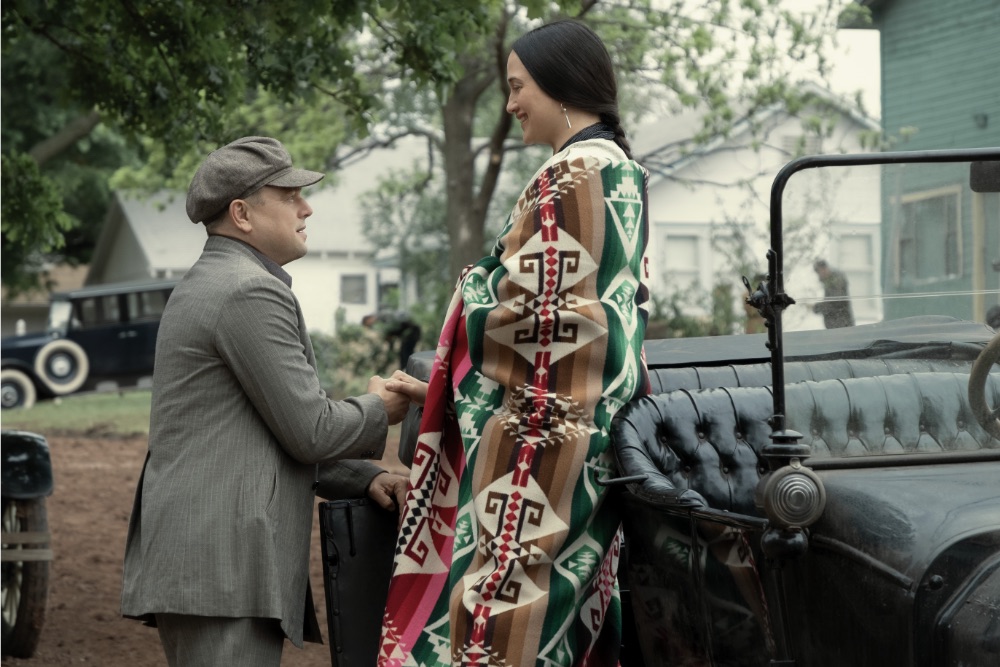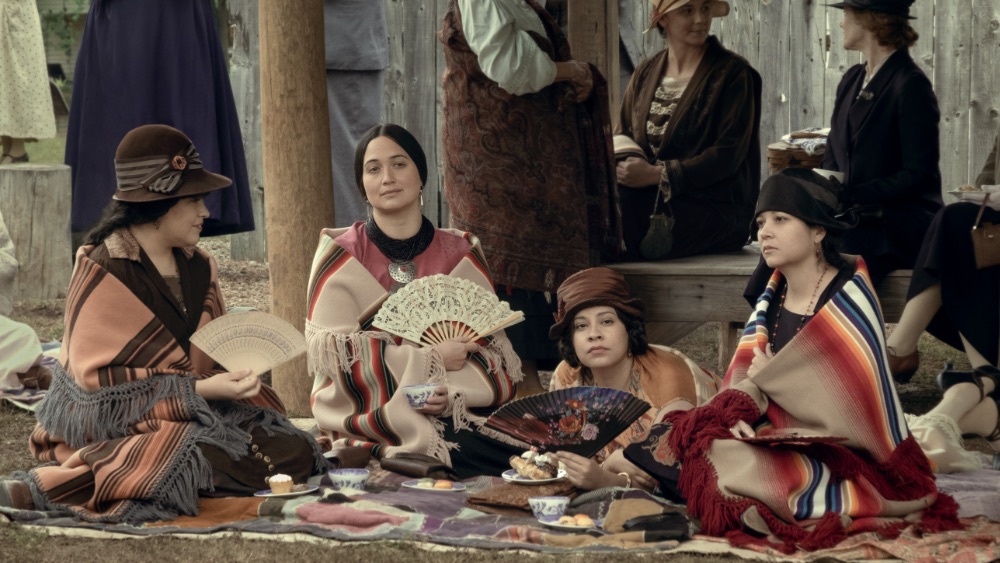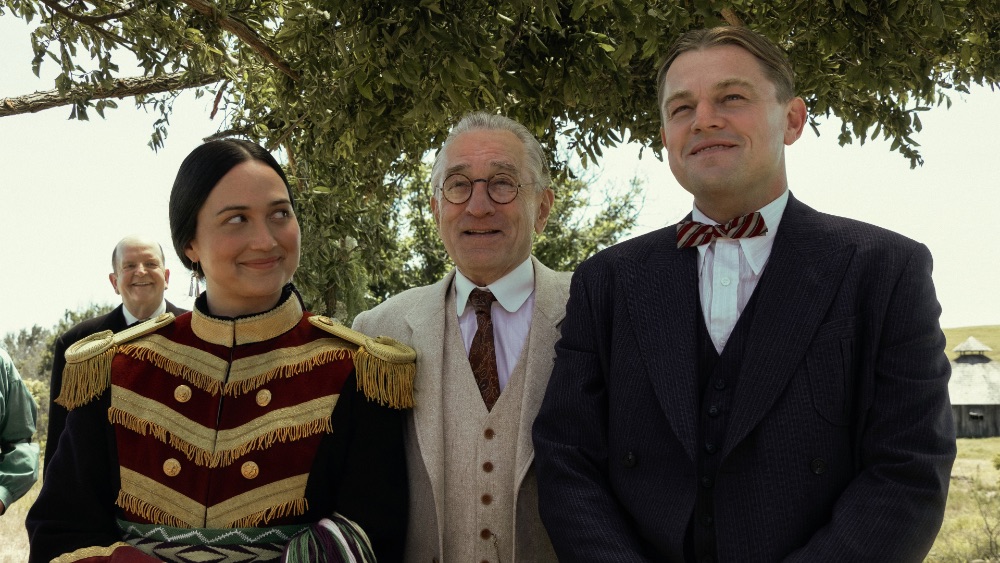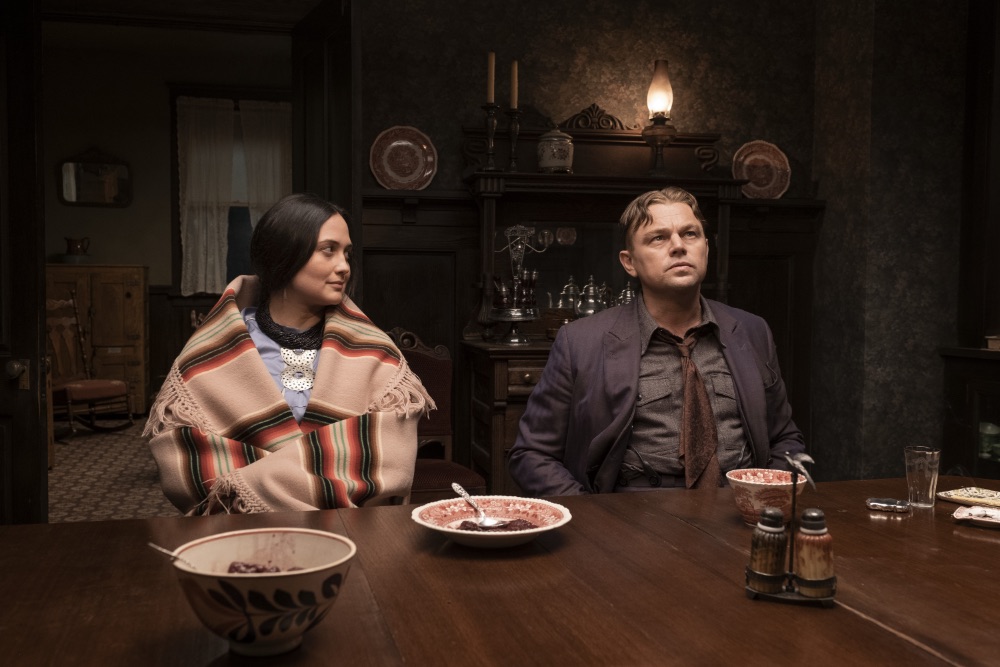One of the great American filmmakers: Martin Scorsese. Telling a memory-holed chapter of American history. It’s a tale about the intersection of colonialism and toxic masculinity, wherein white men believe they are entitled to take whatever they want from whomever they want, no matter whom it damages, no matter who else might have claim to the spoils they seek.
Killers of the Flower Moon is massive, in so many ways. It is epic and essential. It is must-viewing for anyone who cares about acknowledging that the path from the past to the present is more complicated than we (*whispers* we white people) were taught as children. For anyone who understands that the first step to righting the injustices that were perpetrated to get us here is actually being aware of them.
But we cannot consider this the last word on this story. It is but the first (well, the second; read on). It is but a dip of the toe, culturally speaking, in the water of it.

In some ways, though, in the entertainment — using that word cautiously and advisedly — milieu we exist in, Scorsese (Silence, The Wolf of Wall Street) is the perfect teller of this story at this particular moment. The filmmaker has made a career of depicting the harsh realities of deeply problematic men without ever excusing them or their actions. His is the easier toe-dip, because it centers white men, as our stories overwhelmingly do… but then it pulls the rug out to say, as Scorsese always does: Look what pieces of shit these men are.
The reality here, the this-really-happened story, is that the Osage tribe of Native Americans, after many decades of being pushed off their ancestral lands because white Europeans invaders wanted it, finally found themselves shoved into a rocky corner of Oklahoma that the colonizers thought was worthless. But then: oil. Black gold was struck under this last-gasp Osage territory. Thanks to this, by the post-WWI period, the Osage were the richest people, per capita, on the planet. Obviously, this was intolerable to white folks, who clearly deserved to be the beneficiaries of such bounty. *huge woke eye-roll*
This is where Killers of the Flower Moon begins, in the early 1920s. Members of the Osage tribe are being murdered by unknown killers for their headrights, their stake in the land and its oil. This “Reign of Terror,” as the Osage still call it today, had already been going on for years, and would continue for many years more.

Now, the nonfiction work of journalism the film is based on, David Grann’s book of the same name, is an absolutely gripping whodunnit that encorporates a brief history of the Bureau of Investigation, the organization that would become the FBI. Its protagonist is BOI agent Tom White, who eventually figured out who was behind at least some of this horrendous series of brutal murders and ensured they were brought to justice, as much as was possible. The brilliant Jesse Plemons (Jungle Cruise, Game Night) plays White here, but he doesn’t appear until late in the film and is not its protagonist; this story is not about him or the FBI. That would be a piece of white-savior copaganda, which we don’t need any more of. (Yes, the book is still a terrific read. And probably the best first toe-dip into this slice of deliberately forgotten America for our mainstream society as it exists today. Grann also did the journalism behind and wrote the book that The Lost City of Z is based on. The man has dedicated himself to stories that should not have ended up in the cultural trashbin.)
Scorsese’s Flower Moon is not framed as a mystery. (The director also cowrote the script with Eric Roth [Dune, A Star Is Born].) We know from the get-go that the mastermind behind the murders is white rancher William Hale (Robert De Niro: Joker, Joy), who publicly styles himself as a great friend and benefactor to the Osage but privately covets their wealth and sees them as a people whose time has passed. The latter is how he justifies his crimes, which also sounds like a rationale for genocide; he’s just helping along a natural, organic process already in motion, who can say how it started *sad shrug*… as if men like him aren’t to blame for the diminished condition of the Osage culture in the first place. Hale is the banality of evil, and often the deluded self-righteousness of it, in a horrific nutshell.

And then we have Hale’s nephew, Ernest Burkhart (Leonardo DiCaprio: Don’t Look Up, The Revenant), a noncombat veteran — he was an army cook — of the Great War who arrives in Osage country at loose ends, because, we soon appreciate, he is a man of nothing but loose ends. Hale instantly recognizes Ernest as the weak, cowardly, greedy, easily manipulated worm that his nephew is, and begins the sly seduction of Ernest into his grand homicidal scheme. It is not a difficult task.
Both men are nasty pieces of shit, possibly the worst of all the ones whose stories Scorsese has told. (Fuck, at least the mafia has a code of honor, as twisted as it is.) De Niro and DiCaprio are glorious with their sublime portrayals of these awful men. Yes, this is their story, mostly.
My initial reaction to Scorsese’s Flower Moon was that I wish it was more about the Osage people, and particularly the Osage woman whom Ernest charms, marries, has children with, and betrays in so goddamn many ways. Mollie Burkhart, née Kyle, comes from a big family with lots of sisters, and they are tasty targets for Hale. It doesn’t take much nudging for Hale to convince Ernest that marrying Mollie for her headrights is a good idea. The nuanced performances, beautiful in their ugliness, leave room to consider that Ernest might actually love Mollie, in his own stunted way, in the only way allowed by his limited emotional capacity. It’s plain that he loves money more, and is, above all else, terrified of his uncle. The film never casts whatever dim humanity Ernest might have as exculpatory; at best, at absolute best, the shadowed hints of kindness and compassion and tenderness in Ernest are but muted colors in the bolder palette of the toxic masculinity that infects him, and that drives the dominant culture around him.

We’re starting to hear all the many ways in which Scorsese made sure to engage with the Osage nation today during this film’s production. Much of the film is in the Osage language, and Osage cultural consultants advised on the entire process. Which is great! Did Scorsese know that casting force-of-nature Lily Gladstone (First Cow) — who is Native American, though not Osage — as Mollie might even sneakily undermine his centering of Hale and Burkhart? Cuz she stalks this movie like she owns it; she makes Mollie its center of gravity even if every other element does not. Holy shit, she is a talent and a presence to be reckoned with, and she must — absolutely must — get more opportunities to slay like she does here.
I’d like to think that Scorsese recognized that, as a white man, he was not the right person to tell this story from the Osage perspective. (Honestly, we probably would have ripped him if he had tried that, and rightly so. Please, can a Native filmmaker get the resources Scorsese got — $200 million budget, apparently — to tell that story?) But the director did the next best thing: he makes sure that we see, really see, Hale and Ernest for the monsters they are. And by extension, that we really see the monstrosity of colonialism, and how it is driven by the abominable qualities these men represent. And then, when we might start to feel a bit smug in our modern, more enlightened understanding today, he hits us with a gut-punch of a coda that implicates us all in how our complacency allows such horrors to be downplayed, then ignored, then forgotten. Where Scorsese ultimately takes his telling of this story scorches the earth of our presumed superiority.
Killers of the Flower Moon is a tough watch. I don’t mean the runtime: its three and a half hours fly by, and are fully justified. (The incredible score by Robbie Robertson helps; it’s full of Native flutes and drums and is hugely evocative of the draw of the West for whites, of its promise and opportunity, and also mournful of all that was lost because of that; it was an instant purchase for me.) I mean in its straightforward, wide-awake depiction of murderous, selfish violence. I mean in how its central white men are so cheerful, so obliviously lacking in remorse for their crimes… for how they don’t even seem to see their acts as criminal. This is a shocking condemnation of evil, with a definition of evil that is a wider, more encompassing one than we’re used to seeing onscreen from a popular mainstream filmmaker, even one as aware and mindful as Scorsese has always been.

America is very long overdue for a reckoning with the colossal damage its creation caused. (There’s also a burgeoning genre to be found in something we might call climate crimes, as we look back and consider the civilizational, even planetary vandalism that capitalism’s carbon-intensive fuel sources such as oil and coal have, er, powered.) The fact that in some circles, teaching American children about American slavery is controversial says that plenty Americans know that there are wrongs that need to be accounted for, and that they fear what facing them means. The reckoning will not be pleasant! But it is so very necessary.
Glimmers of hope for our awakening have sprung up before. Killers of the Flower Moon could be yet another one that sparks hot then fizzles quickly. I hope not. A better world, a fairer world is possible, but we have to pay attention when the things that have not been fair, that many of us were not previously aware of, are brought to our attention. I hope we will listen to this lesson.
viewed during the 67th BFI London Film Festival
more films like this:
• There Will Be Blood [Prime US | Prime UK | Apple TV | Paramount+ US | Paramount+ UK | Netflix UK]
• Dances with Wolves [Prime US | Prime UK | Apple TV]
























